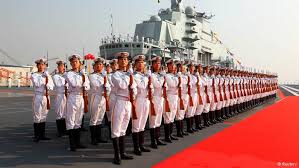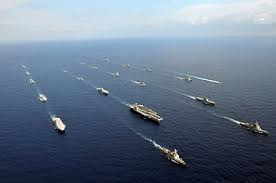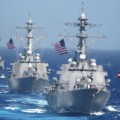Vernuccio’s View: Most Dangerous Maritime Dispute
 The world’s most dangerous maritime dispute is awaiting a ruling from the Permanent Court of Arbitration in The Hague. China has unlawfully laid claim to almost the entire oceanic area known as the South China Sea, and which the Philippines call the West Philippine Sea. It encompasses a 1,400,000 square mile region from Singapore and the Malacca Straits to the Strait of Taiwan. A third of the planet’s shipping transits through it, and huge deposits of oil and gas, as well as a wealth of fish, are contained within.
The world’s most dangerous maritime dispute is awaiting a ruling from the Permanent Court of Arbitration in The Hague. China has unlawfully laid claim to almost the entire oceanic area known as the South China Sea, and which the Philippines call the West Philippine Sea. It encompasses a 1,400,000 square mile region from Singapore and the Malacca Straits to the Strait of Taiwan. A third of the planet’s shipping transits through it, and huge deposits of oil and gas, as well as a wealth of fish, are contained within.
The Philippines initiated proceedings against Beijing in accordance with the United Nations Law of the Sea. International Law would classify maritime features, including hundreds of very small uninhabited spots, many of which are now questionably claimed and some occupied by China’s military, as rocks, low tide elevations, or submerged banks, but not islands, which overturns China’s claims to use those already disputed sites as a way to extend its claims over ocean areas.
The Philippines simply seek to have the right to operate within its own exclusive economic zone restored and have access to its key offshore areas without Chinese harassment.
 China has already stated that it has no intention of abiding by the results, and rejects the jurisdiction of The Hague. In other related disputes in the area, Beijing has not been cooperative in attempts to negotiate the issue through regional talks, preferring to deal separately with each national claimant, a tactic that allows it to use armed intimidation as an effective tool. China’s General Luo Yuan said his nation should be prepared for “war at all costs” to enforce its claims, according to a commentary posted on china.org.cn.
China has already stated that it has no intention of abiding by the results, and rejects the jurisdiction of The Hague. In other related disputes in the area, Beijing has not been cooperative in attempts to negotiate the issue through regional talks, preferring to deal separately with each national claimant, a tactic that allows it to use armed intimidation as an effective tool. China’s General Luo Yuan said his nation should be prepared for “war at all costs” to enforce its claims, according to a commentary posted on china.org.cn.
Writing in the Asia Times National Security author Bill Gertz writes that “China’s takeover of the South China Sea is nearly complete and Beijing is now stepping up its sophisticated information warfare campaign in preparation for an expected unfavorable ruling from an international tribunal affecting its island claims… The strategic goal of China in the South China Sea is to solidify control over the waters without firing a shot, in much the same way as Russia was able to do with its military annexation of Ukraine’s Crimea in March 2014. The People’s Liberation Army (PLA) refers to this as the use of “military soft power.”
 During the past several years, unrestrained by a weakened American navy and an irresolute President, China has laid claim to most of the South China Sea region. The basis of China’s claim is what it describes as a “Nine Dash Line,” which, according to U.S. sources, is “a Chinese map of the South China Sea showing nine line segments that, if connected, would enclose an area covering roughly 90% [of the entire region.] …The area inside the nine line segments far exceeds what is claimable as territorial waters under customary international law of the sea… and includes waters that are within the claimable [and internationally recognized] (and in some places are quite near the coasts) of the Philippines, Malaysia, Brunei, and Vietnam.”
During the past several years, unrestrained by a weakened American navy and an irresolute President, China has laid claim to most of the South China Sea region. The basis of China’s claim is what it describes as a “Nine Dash Line,” which, according to U.S. sources, is “a Chinese map of the South China Sea showing nine line segments that, if connected, would enclose an area covering roughly 90% [of the entire region.] …The area inside the nine line segments far exceeds what is claimable as territorial waters under customary international law of the sea… and includes waters that are within the claimable [and internationally recognized] (and in some places are quite near the coasts) of the Philippines, Malaysia, Brunei, and Vietnam.”
Under the Obama Administration, little of substance has been done to discourage China’s aggressive actions. The White House has refused to side with America’s allies such as the Philippines or Japan when China engaged in provocative actions against those nations. Even as China used force in furtherance of its goals, all the U.S. Administration did was to encourage a “peaceful resolution,” an act which some has said was a betrayal of allies, and a complete denial of the rule of law which objective observers note rejects Beijing’s claims.
President Obama has emphasized what the Administration describes as a “pivot to Asia” of U.S. armed forces, in response to China’s actions. However, the substance of the pivot involves comparatively little force, since the U.S. navy is now a shadow of its former size, the smallest it has been since before World War 1, and China, in contrast, has dramatically built up the size of its forces. It now has more submarines than the U.S. Navy, and its fleet will outnumber America’s within four years. Beijing also has extraordinary new land based weapons, such as the DF-21missile which can destroy American naval vessels at a distance of 900 miles.
The President has concluded agreements with Vietnam as a means to stiffen regional resistance. However, speaking in Hawaii, Mr. Obama denied the deal was aimed at China.
Frank Vernuccio serves as editor-in-chief of the New York Analysis of Policy & Government















Follow Us